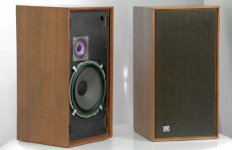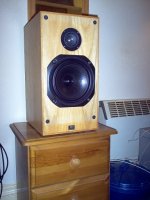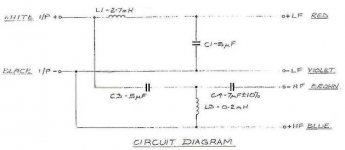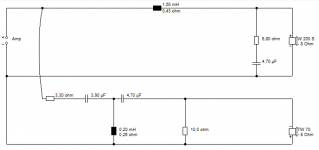LOL!
However, it does make for good marketing and
product differentiation!
And that counts! You know Doc, you're the only one laughing
at my jokes. There is a hope for me to get out of this institution
I found my self in, after some serious
 .
.Sincerely yours,
Wyatt
And that counts! You know Doc, you're the only one laughing
at my jokes. There is a hope for me to get out of this institution
I found my self in, after some serious.
Sincerely yours,
Wyatt
I agree Wyatt. Some people take this stuff WAYY too seriously. 😀
Whenever I hear the phrases LR4 or asymettric filter, I step back a bit. 🙂
My advice is just to build a solid box, and stuff a couple of drivers in and sit back and enjoy it. Preferably with some cheap cone tweeter of course.
What's hard about it, after all? 😎
All I can say is that I've BEEN THERE with HUGE and OVERSPECIFIED capacitors! 😀
The below example is a huge 0.1uF 1200V jobbie that I somehow ended up with. Can't fault it of course, but probably overkill...😱
No idea about polarity, of course. 😕
Of course, what drives up the size quickly is the VDC ratings. Now, if we believe all that Tony Gee has to implicitly say about his cap ratings vs voltage ratings, more voltage is better!
Me think that the "Hifi gently descending FR curve" statement had madePreferably with some cheap cone tweeter of course.
you to think and act that way 😛
There's very good reasons to think a cheapie cone tweeter works better than a dome, pico! They both resonate around 7kHz, but the cone absorbs the resonance, whereas the dome radiates it. Having used both, I know which sounds better if you discount the better dispersion of the dome. 🙂
On the subject of capacitors, I have actually got a good engineering grounding in filters. Professor Tony Constantinides of Imperial College often explained that component tolerances really only have an effect at -3db crossover. Outside that the filter is simply passing the signal unaffected. It's effectively a short circuit.
Someone was always going to say this, but I seriously doubt if capacitor upgrades make much difference. Better a filter topology that works nicely on phase.
My own current interest is a simple closed box 8" bass plus tweeter two way. It comes out sounding remarkably similar to the the famous Wharfedale Linton that sold in millions in the seventies. I have done a lovely filter though. Well, IMO. 😎
On the subject of capacitors, I have actually got a good engineering grounding in filters. Professor Tony Constantinides of Imperial College often explained that component tolerances really only have an effect at -3db crossover. Outside that the filter is simply passing the signal unaffected. It's effectively a short circuit.
Someone was always going to say this, but I seriously doubt if capacitor upgrades make much difference. Better a filter topology that works nicely on phase.
My own current interest is a simple closed box 8" bass plus tweeter two way. It comes out sounding remarkably similar to the the famous Wharfedale Linton that sold in millions in the seventies. I have done a lovely filter though. Well, IMO. 😎
Attachments
Last edited:
I agree Wyatt. Some people take this stuff WAYY too seriously. 😀
Whenever I hear the phrases LR4 or asymettric filter, I step back a bit. 🙂
My advice is just to build a solid box, and stuff a couple of drivers in and sit back and enjoy it. Preferably with some cheap cone tweeter of course.
What's hard about it, after all? 😎
I do hope that was a joke? People come here to learn not how to build a speaker from 1960.Slapping drivers in a box, hanging a single cap on the tweeter and calling it a day isn't how to improve anything.😛
Slapping the RIGHT drivers in a simple solid box is probably the trick! 😀
Then give it a decent crossover which works with the drivers. No simple caps for me. No snake oil either. 🙂
I was amazed by this old KEF Celeste 3 speaker when I simmed the filter. It gets phase exactly right. The soft dome is a bit of a horror IMO, but it led to a much better design with a cheapie £6 Monacor HT22/8 cone tweeter.
This really works well. Cheap too. 😎
Sorry, a bit off-topic I suppose. 😱
Then give it a decent crossover which works with the drivers. No simple caps for me. No snake oil either. 🙂
I was amazed by this old KEF Celeste 3 speaker when I simmed the filter. It gets phase exactly right. The soft dome is a bit of a horror IMO, but it led to a much better design with a cheapie £6 Monacor HT22/8 cone tweeter.
This really works well. Cheap too. 😎
Sorry, a bit off-topic I suppose. 😱
Attachments
Last edited:
- Status
- Not open for further replies.
- Home
- Loudspeakers
- Multi-Way
- Polarity of the capacitors Auricap




